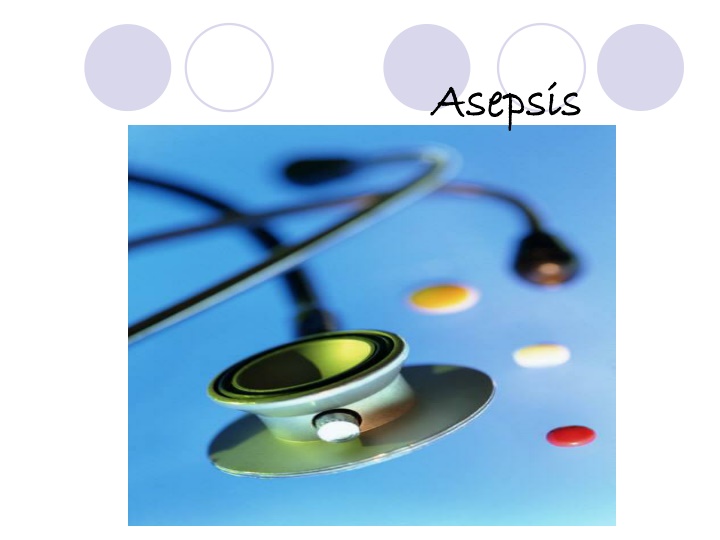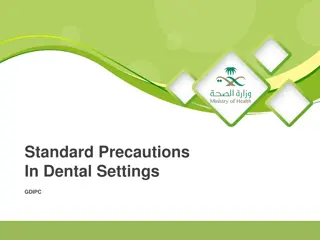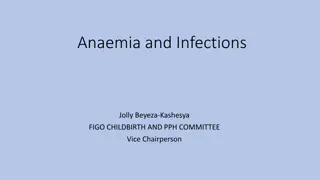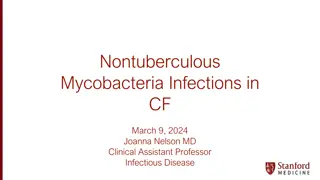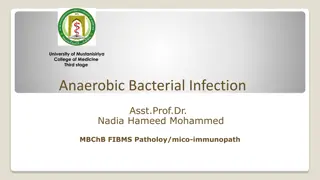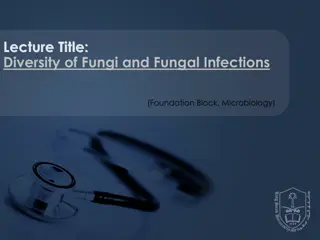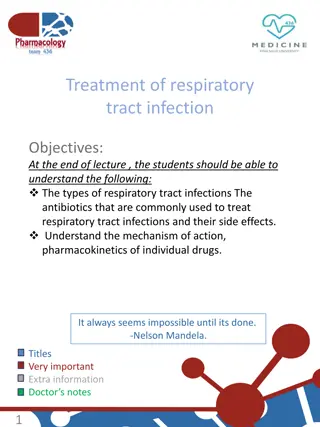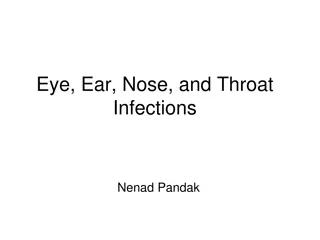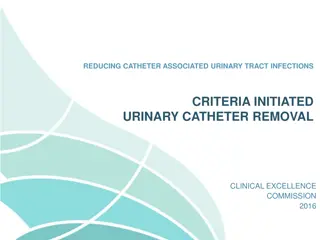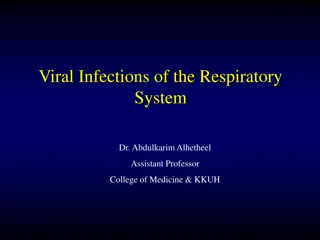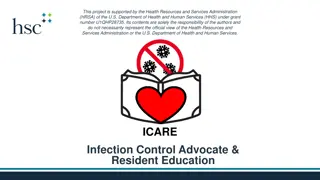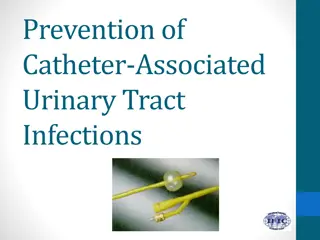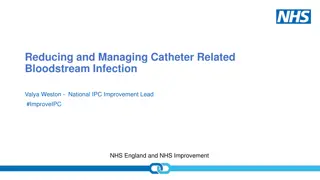Asepsis, Infections, and Control Measures
Asepsis refers to the freedom from disease-causing microorganisms, while infections result from the invasion and proliferation of microorganisms in the body. Explore terms like virulence, sepsis, and types of infections, including nosocomial infections. Understand the chain of infection and how microorganisms spread, emphasizing the importance of medical and surgical asepsis in limiting infection transmission.
Download Presentation

Please find below an Image/Link to download the presentation.
The content on the website is provided AS IS for your information and personal use only. It may not be sold, licensed, or shared on other websites without obtaining consent from the author.If you encounter any issues during the download, it is possible that the publisher has removed the file from their server.
You are allowed to download the files provided on this website for personal or commercial use, subject to the condition that they are used lawfully. All files are the property of their respective owners.
The content on the website is provided AS IS for your information and personal use only. It may not be sold, licensed, or shared on other websites without obtaining consent from the author.
E N D
Presentation Transcript
Asepsis Asepsis
Related terms Normal resident flora (bacteria) the collective vegetation in a given area, yet produce infection in another. Infection : invasion and proliferation of microorganisms in certain body tissues. Disease : a detectable alteration in normal tissue function
Related terms Virulence(Pathogenicity):the ability of microorganism to produce disease. Opportunistic pathogen CDC (Centre for Disease Control)
Asepsis Asepsis The freedom from disease-causing microorganisms Medical asepsisall practices used to limit the number of microorganisms, growth and transmission. - Clean objects: absence of almost all microorganisms. - Dirty (Soiled, Contaminated) : have microorganisms, some of which capable of causing infection. Surgical asepsis (Sterile Technique): practices that keep area or object free from all microorganisms (sterilization by using autoclave). Sepsis : the state of infection, may includes septic shock.
Microorganisms causing infections Bacteria (Staphs, Streptococci) Viruses (Hepatitis, Herpes..) Fungi (Candida albicans) Parasites (Malaria) (mites, flees, ticks).
Types of infections Types of infections Septicemia : when bacteremia results in systemic infection. Colonization :microorganisms become resident flora, they may grow and multiply, but do not cause disease. Acute infection : sudden and in short time. Local Infection : infection limited to specific area of the body. Chronic infection : slow and in very long period. Systemic Infection : spread to different parts of the body. Bacteremia : Blood culture reveals microorganisms
Nosocomial Infections Infections associated with delivery of health care services in a health care facility (during stay or after discharge) Examples : UTI S, URTI S, Surgical site infection, Blood stream infections. It may originates as Endogenous or Exogenous. Iatrogenic (IV insertion) (Dx. or Rx.).
Chain of Infection Chain of Infection Microorganism Etiologic agent Susceptible Host Portal of Entry to susceptible host Reservoir Method of Transmission Portalof Exit from reservoir
Example on Chain of Infection Hepatitis B Virus Susceptible Host Human being HBV HBV HBV Portal of Entry to susceptible host Blood, secretions Reservoir CARRIERS Method of Transmission Blood, Sexual intercourse Portalof Exit from reservoir Open wound, needle, mucous memebrane
Method of transmission 1. Direct transmission : droplet, touch, bite, sexual intercourse. Indirect transmission: - Vehicle-borne (handkerchiefs, toys, soiled clothes) - Vector-borne (animals, flies) 2. 3. Airborne transmission (Tuberculosis) (droplet nuclei).
Body Defense against infection (Susceptible Host) Nonspecific Defenses : - anatomic & Physiologic Barriers - inflammatory response : vascular and cellular response, exudates production, reparative phase Specific Defenses : - antibody-mediated (active & passive immunity) - cell-mediated (HIV)
FACTORS INFLUENCE SUSCEPTIBILITY OF THE HOST Age Heredity Stressors Nutritional status Medical therapy
Nursing Diagnoses Nursing Diagnoses Risk for infection Potential complication of infection: fever Impaired physical mobility Imbalanced nutrition: less than body requirements Acute pain Impaired social interaction or social isolation Situational low self-esteem Anxiety
Nursing interventions in infection control and prevention of NCI S. Hand washing: 1. - before and after eating - after using toilets, bedpan - contact with body substance (sputum, drainage, wound exudates). use: antimicrobial foam, hand gel, water (10 min.) with soap, antimicrobial liquid soap. When using antimicrobial agent: - multiple resistant bacteria - invasive procedures - SCBU, ICU S - immune-compromised patients. Frequent use may induce: dryness, contact dermatitis lotions, moisturisers
http://benjihadafieldandhelostit.blogspot.com/2008/10/happy-global-hand-washing-day.htmlhttp://benjihadafieldandhelostit.blogspot.com/2008/10/happy-global-hand-washing-day.html
Nursing interventions in infection control and prevention of NCI S. (Hand washing) .. Nails should be kept short Remove jewelry Skin breaks
Nursing interventions in infection control and prevention of NCI S. 2. Supporting defense: - Hygiene (bathing and shampooing) - Nutrition (well-balanced diet) to maintain healthy tissues. - Rest and sleep - Immunization
Nursing interventions in infection control and prevention of NCI S. 3. - use gloves - rinse with cold water - wash with hot water and soap - use brushes in cleaning - dry up equipments - clean used utensils by disinfectant. Cleaning objects
Nursing interventions in infection control and prevention of NCI S. 4. - using chemical preparations such as phenol or iodine compounds. - used on inanimate objects as it is toxic to tissues. - more concentrated than antiseptics. - bactericidal (destroy bacteria) and bacteriostatic (prevent growth and reproduction of some bacteria) agents. - concentration, duration, temp, organic materials are important to consider when using disinfectants. Disinfection
Nursing interventions in infection control and prevention of NCI S. 5. - is the process of destroying all microorganisms, including spores and viruses. - Moist heat: steam+ pressure or free steam (autoclaving: 15- 17pound/121-123 c/ 20- 30 min. Sterilization
Nursing interventions in infection control and prevention of NCI S. (sterilization) . Gas sterilization Ethylene oxide gas (interferes with metabolism of microorganisms) for sensitive objects and more penetration. Radiation using ionizing and non- ionizing radiation (UV rays). It is very expensive. Boiled water 100 c/ 15 min
Nursing interventions in infection control and prevention of NCI S. 6. Isolation Precautions: measures designed to prevent spread of infections to health personnel, clients and visitors. Standard precautions: - for all clients in hospital. - blood, body fluids and secretions, broken skin, mucous membranes. - includes: hand washing, wearing clean gloves, wearing mask, eye protection, face shield, wearing a clean non- sterile gown, correct disposals and prevent injuries
Nursing interventions in infection control and prevention of NCI S. (Isolation Precautions .. Transmission-based precautions (airborne- precautions): - private room, negative air pressure, 2-same infected clients. - respiratory device - NO entry in cases (rubella, measles, chickenpox- varisella) - limited movement of the patient (surgical mask).
Nursing interventions in infection control and prevention of NCI S. (Isolation Precautions .. Droplets precautions - Used in droplet- transmitted D s (diphtheria- pertussis-mumps) - private room - mask - limit patient s movement (surgical mask).
Nursing interventions in infection control and prevention of NCI S. (Isolation Precautions .. Contact precautions - used in serious illnesses and immune-compromised patients (wound infections, MRSA) - private room - wear gloves - wear gown - limit movement
Nursing interventions in infection control and prevention of NCI S. 7. Personal protective equipments (medical asepsis) - Gloving - Gowns - Eyewear
Nursing interventions in infection control and prevention of NCI S. Disposal of soiled equipment and supplies: - Bagging - Linens - lab. Specimens - Dishes - BP equipments - Thermometers - Sharps
Nursing interventions in infection control and prevention of NCI S. 9. Sterile technique (surgical asepsis) - can be used in OR, LR, and special Dx. Procedures - sterile field: a microorganism- free area - ensure package intact and dry, and check for sterilization expiry. - double packed objects - using forceps, drape, sterile solutions. - wearing sterile gloves by open and closed methods - wearing sterile gown
